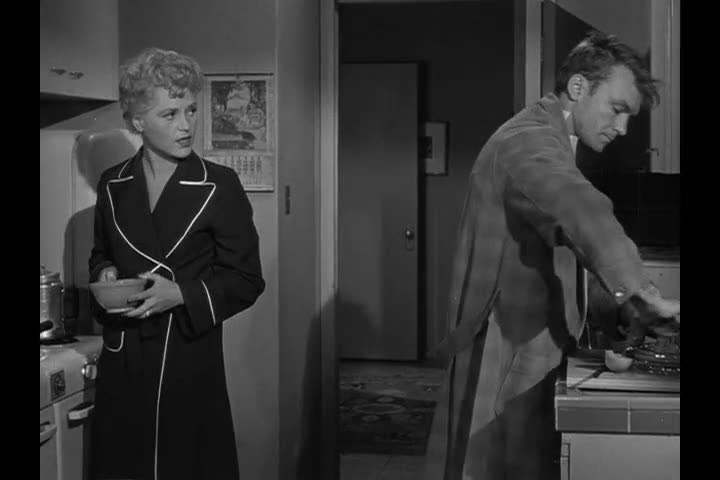|
Genres, Themes, Actors, and Directors:
- Aldo Ray Films
- Divorce
- Flashback Films
- George Cukor Films
- Judy Holliday Films
- Marital Problems
- Romantic Comedy
Response to Peary’s Review:
Peary accurately argues that this “captivating film” — directed by George Cukor, and scripted by Ruth Gordon and Garson Kanin — is “way ahead of its time” in its hard-hitting blend of “comedy and extreme tragedy”, telling the tale of a “lower-middle-class couple [who] experience a kind of therapy” while relating their story to a judge, “revealing feelings that they never expressed to each other”. He writes that while Holliday and Ray’s characters clearly “loved each other”, they “have ego problems which could be solved if they just expressed their true feelings for each other”. He notes that they “seemed to bring each other bad luck”, citing an instance he refers to as “one of the most painful scenes in movie history”, in which Holliday “has the opportunity to win a lot of money on a radio quiz by correctly naming a tune”, but instead “gives Ray’s guess instead of her own and they lose”.
I actually don’t find this scene particularly painful, given Holliday’s loving attempts to smooth the situation over: “Money you get that way doesn’t do you any good”, she reassures her depressed husband. It’s a later, tragic scene — one following on the heels of Holliday singing a delightful ditty (“Dolores”) while strumming a ukelele — that tears me up inside each time I think of it (though I won’t say more at risk of spoiling).

Indeed, Kanin and Gordon’s willingness to include truly hard-hitting scenes such as this one is part of what sets The Marrying Kind apart from other romantic comedies of its era. Equally innovative is their incorporation of voice-overs during flashback scenes, as we hear either Ray or Holliday telling their version of what happened while we simultaneously watch the “truth” unfold in front of us; it’s a remarkably effective strategy, shaking us out of our complacency as viewers.
Hunky newcomer Aldo Ray was an interesting choice to play Holliday’s postman-husband, Chet. While he suits the bill nicely in many ways (he’s believable as a blue collar worker, and seems invested in his role), his acting lacks nuance at times. More than making up for this, however, is Holliday, who gives a typically stellar performance as Florence (a.k.a. Florrie). In Alternate Oscars, Peary names Holliday Best Actress of the Year, noting that the role “was designed as a showcase for her, to prove that she had enough versatility to play in all kinds of films and that she could play a real character”. He writes that “like other Holliday characters, Florence is funny and endearing, and has a singular logic about life, which completely befuddles everyone else, including Chet… She seeks happiness along a rocky road, stubbornly refusing to compromise her way of doing things”. Yet he points out that “she can be extremely aggravating, insensitive, unsupportive, unforgiving, even selfish” — in other words, she’s an equal partner in the dissolution of her marriage. Holliday’s performance makes this film must-see viewing at least once, though the film itself is also a hidden gem.
Redeeming Qualities and Moments:
- Judy Holliday as Florrie (named Best Actress of the Year in Alternate Oscars)

- Ruth Gordon and Garson Kanin’s creative, incisive script
Must See?
Yes, as an unsung classic, and for Holliday’s performance.
Categories
- Good Show
- Important Director
Links:
|
One thought on “Marrying Kind, The (1952)”
A once-must, as a unique story about the commonplace, and for Holliday’s performance.
Some may actually think that, in a way, this isn’t much of a film, perhaps in the sense that it’s not about much. But it’s actually about quite a lot.
It’s mostly, and quite simply, about human nature in close, intimate quarters. And that’s a lot.
Holliday and Ray’s characters don’t have insurmountable problems in their marriage; there’s nothing dysfunctional in a major way, no physical or mental problems that might also affect the world in general.
They fell in love without knowing each other all that well. But even though they were genuinely in love, learning how to communicate – to take that leap into the territory of a relatively unknown human being – can alone at times seem insurmountable.
You can only try your best to know another human being, especially one you marry. And, as the title tells us, these two are ‘the marrying kind’ at heart.
I thought it was a nice touch at one point to include and illustrate the fact that problems in a relationship can’t really be solved or enlightened by talking with friends or other couples. Each couple is unique – and those in the relationship need to be willing to fight for the relationship, for understanding…if the love is there.